Dinosaur Fossil Decor: Merging Aesthetics and Science
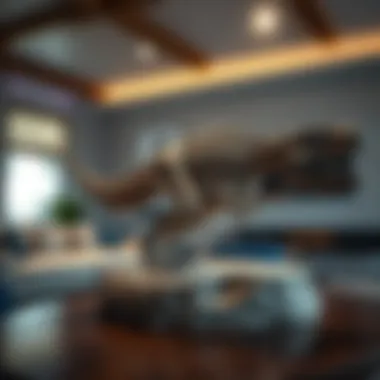
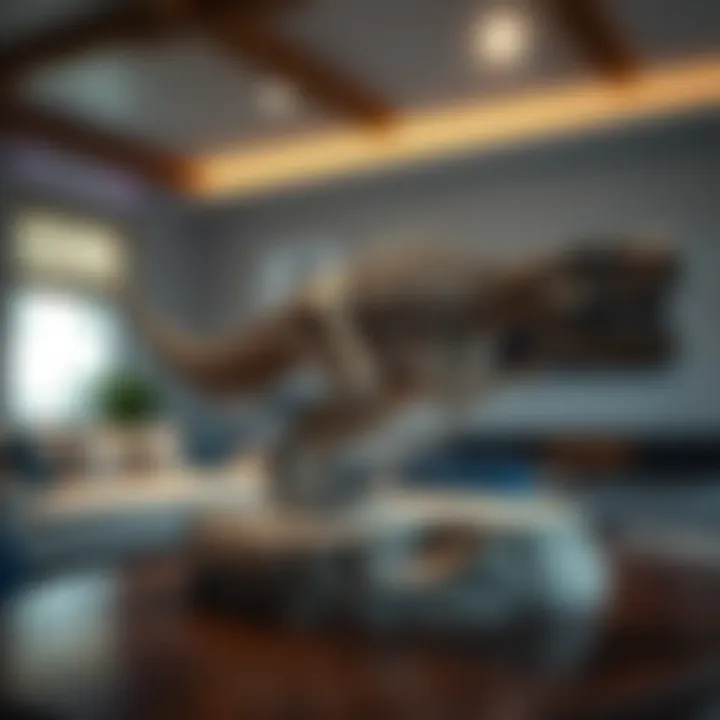
Intro
Dinosaur fossils hold a remarkable allure, bridging the gap between science and art in interior design. The integration of these ancient relics into modern decor is not just a trend; it’s a captivating journey that touches upon aesthetics, history, and culture. From the fossilized bones of mighty T-rexes to the delicate imprints of small dinosaurs, these pieces tell stories that resonate deeply with collectors and decor enthusiasts alike.
In this exploration, we will journey through the historical significance and cultural impact of dinosaur fossils. We will also provide a guide to identifying various fossils and discuss common categories that collectors cherish. Understanding how to blend these unique artifacts with contemporary design principles can elevate any living space, transforming it from mundane to extraordinary. Through thoughtful incorporation of fossil decor, one can capture the essence of time itself—an echo of life long gone, presented in a form that speaks to aesthetic aspirations and scientific curiosity.
Each section below unravels the multifaceted nature of dinosaur fossils in decor—urging us to consider how these remnants of prehistoric life can inspire modern living. Whether you are a seasoned collector or someone simply drawn to the charm of natural history, this guide aims to enrich your appreciation and approach.
History and Origins
Overview of Collectibles, Rocks, and Fossils
The fascination with fossils isn't a modern phenomenon. From ancient civilizations to contemporary collectors, fossils have sparked curiosity and wonder. Collectibles often embody the intersection of personal passion and educational value, whether they’re found in dusty old books or modern exhibitions. Fossils, particularly those of dinosaurs, serve as a tangible connection to life millions of years ago. Each fossilized fragment is a unique collectible that captures a snapshot of prehistoric ecosystems.
In home decor, fossils start to take on new identities. Instead of merely being scientific specimens confined to museums, they become conversation starters, creative accents, and even centerpieces in design schemes. The transition from a scientific exhibit to aesthetically pleasing decor indicates a growing appreciation for natural history as an art form.
Historical Significance and Cultural Impact
Dinosaur fossils have long held a special place in cultural narratives. The awe surrounding these ancient creatures has inspired countless tales in mythology and literature. For instance, the notion of dragons in various cultures may have been influenced by fossil discoveries, blending the realms of reality and imagination.
In recent history, as paleontology evolved into a respected science, the public's interests deepened. The late 19th and early 20th centuries saw a surge in fossil discoveries, coinciding with the rise of popular culture and media on dinosaurs. Films and literature have dramatized their existence, making these creatures central figures in our collective consciousness.
Moreover, showcasing dinosaur fossils in decor reflects a longing for connection with nature and history. Home environments decorated with fossil replicas often evoke a sense of wonder, celebrating the grandiosity of life that once roamed the earth. This aesthetic practice transforms spaces, turning them into reflections of one’s interests and the intrinsic beauty of natural history.
"By featuring fossils in our living spaces, we invite the past to coexist with the present, each piece conveying its own narrative of life beyond time."
In summary, dinosaur fossils are much more than mere curiosities; they have woven themselves into our cultural fabric and artistic expression. They inspire creativity, evoke nostalgia, and serve as a testament to an era far removed from our own. As we continue to explore how to identify and classify these remarkable pieces, we will discover ways to seamlessly incorporate them into the very heart of our homes.
Understanding Dinosaur Fossils
In a world where time often seems like a flat plane, dinosaur fossils serve as remarkable windows into life millions of years ago. They are not just relics; they embody a rich history that enthralls scientists and enthusiasts alike. Understanding these fossils is invaluable, as they are pivotal in piecing together the evolutionary narratives that shape not only our past but also modern perceptions of life.
Definition of Dinosaur Fossils
Dinosaur fossils are the preserved remains or traces of dinosaurs, which include bones, teeth, footprints, and even eggs. These remnants provide critical insights into the anatomy, behavior, and habitat of these ancient creatures. Defined broadly, they serve as time capsules, allowing us to understand not just the organisms themselves but also the environments they thrived in. Through careful study, paleontologists categorize them into various types, such as body fossils and trace fossils, leading to a deeper understanding of biological diversity and extinction events.
The Formation Process
Fossilization phenomena
The journey from a living dinosaur to a fossil is quite intricate and fascinating. Fossilization phenomena describe the processes through which organic material is transformed into fossilized remains. This process includes burial in sediment, mineralization, and, over eons, replacement of organic tissues by minerals. This natural metamorphosis is nothing short of extraordinary, as it maintains intricate details of the organism, allowing modern scientists to reconstruct and visualize ancient life forms. The key characteristic of this process lies in its ability to yield fossils that are not mere bones, but records of past ecosystems.
However, not every organism becomes a fossil. The likelihood of fossilization depends on numerous factors, including the environment where the organism perished and the conditions present afterward. This brings us to a vital aspect of fossilization.
Environmental factors impacting fossilization
Environmental factors play a crucial role in whether an organism will fossilize. Conditions such as sedimentation rates, climate, and biological decay often dictate the fossilization outcome. For instance, rapid burial in a sediment-rich environment drastically increases the chances of fossilization, as it protects remains from decomposition, scavengers, and other natural erosive forces.
Understanding these elements is beneficial because it highlights the delicate balance of life and death in prehistoric ecosystems. Additionally, these unique features emphasize how the fossilization process is influenced by myriad natural events, which in turn helps us form a narrative about Earth’s changing environments over time.
Historical Significance
Cultural impact in ancient times
In ancient cultures, dinosaur fossils were often misinterpreted. Many societies attributed these enormous bones to mythical beasts or giants, shaping their folklore and understanding of the world. This cultural impact marks an essential point in human history, demonstrating how early interpretations of natural phenomena sparked curiosity, leading to myths and legends that permeate our stories today. Recognizing this cultural connection enriches our modern relationship with these fossils, infusing them with historical narrative and cultural significance.
Modern interpretations of fossils
As our understanding advanced, modern interpretations have shifted, embracing a more scientific perspective. Today, fossils provide not just a glimpse into the past but also inform various fields, including art, design, and education. Museums display dinosaur fossils to engage the public, nurturing a fascination for paleontology and natural history.
Contemporary approaches are benefiting from advanced technology, yielding remarkable reconstructions of ancient life forms and ecosystems. Such interpretations inspire not only scientific inquiry but also artistic expressions in homes, blending aesthetic appeal with educational value. This integration of science and art showcases how fossils can transcend mere artifacts, becoming pivotal elements in our collective appreciation for the past.
"Fossils are the footprints of our planet's history, telling stories we yearn to understand."
In summary, understanding dinosaur fossils goes beyond naming them; it’s about unraveling their stories, appreciating their formation processes, recognizing their historical impact, and seeing how they have shaped our world both scientifically and culturally. This knowledge lays the groundwork for how these ancient relics find their place in modern decor, as both aesthetic pieces and symbols of a time when giants roamed the Earth.
Dinosaur Fossils in Home Decor
Dinosaur fossils have carved out a fascinating niche in the realm of home decor, blending aesthetics with a touch of ancient wisdom. These relics, remnants of a time long gone, provide homeowners not only with artistic pieces but also a conversation starter that invites curiosity and wonder. The significance of integrating dinosaur fossils into home decor stretches beyond their visual appeal; it encompasses a celebration of our planet's rich history and the artistry that can arise from it.
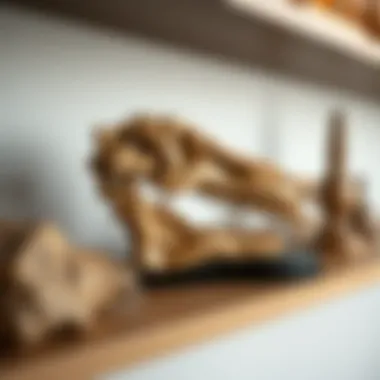
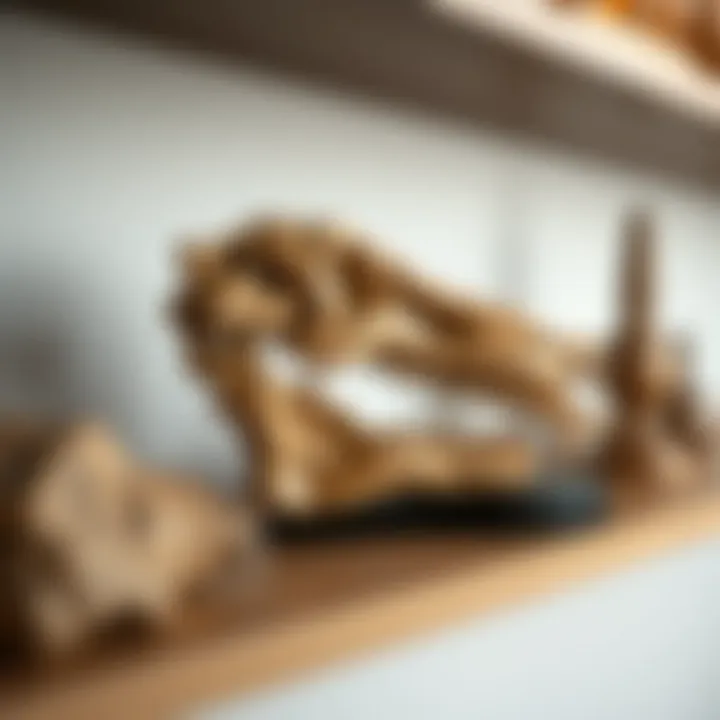
Decorating with fossils encapsulates various elements that enhance living spaces. First, there's the undeniable allure of having a piece of the past within four walls, evoking thoughts on evolution and the earth's transformative journey. Second, these fossils offer a unique texture and form that can complement or even elevate design motifs—whether you favor a rustic look or a modern aesthetic.
Consideration for incorporating these elements involves an understanding of their origins. It’s essential to choose pieces that resonate with personal style while also reflecting quality craftsmanship. Dinosaurs may be distant relatives in terms of time, but their representation in decor brings a fresh, engaging narrative that engages the human spirit in a tangible way.
Selecting the Right Fossil Decor
Choosing the right fossil decor can seem like a daunting task, but it adds layers of meaning and aesthetic appeal to any space. It’s not just about picking something that looks neat on a shelf; it’s about embracing the story behind those ancient relics and how they can enrich your environment. In this section, we'll explore what to look for when selecting fossil decor, as well as dive into the finer details like materials and craftsmanship, ensuring your collection is both visually striking and scientifically grounded.
Identifying Quality Replicas
Materials used
When it comes to selecting replica fossils, the choice of materials is pivotal. High-quality replicas often utilize resins or durable plastics that mimic the textures and colors of genuine fossils. These materials are beneficial because they provide resilience against wear and tear. For example, using high-density polyurethane not only captures the intricate details of the fossil but also withstands time and environmental changes better than other less sturdy options.
Another material that stands out is high-quality stone composite. It incorporates real stone elements, adding to both the authenticity and the aesthetic appeal. However, one must be cautious as the weight and handling requirements can create challenges in arrangement and display.
The uniqueness of these materials is that they allow for a more faithful representation of the original fossils while continuing to provide a level of accessibility for collectors.
Craftsmanship considerations
Craftsmanship is just as important as the materials used. When identifying quality replicas, one must look for intricate detailing that dare to mimic the very complexities found in real fossils. Pieces that are handcrafted by skilled artisans often display a level of attention that automated processes can overlook. This human touch can make all the difference in achieving a realistic look.
Moreover, the finish of a replica can greatly impact its aesthetic appeal. A matte finish might evoke an ancient feel, while a polished look can lend a modern air to a fossil piece. Each choice reflects a different narrative and experience, so it’s essential to consider what mood you aim to create in your environment.
However, keep an eye out for mass-produced replicas that may sacrifice detail or structural integrity for lower costs. They might catch your eye initially, but they can be a letdown in the long run if they lack the craftsmanship to stand the test of time.
Choosing Sizes and Shapes
Balancing scale in room design
The scale of fossils in decor is one of those elements that can’t be glossed over. A massive dinosaur skull might be the centerpiece in a spacious living room, but in a small apartment, it could turn into an overwhelming presence. Balancing the size between your fossil decor and the elements around it will create a harmonious flow in the space.
Often, larger pieces can draw attention and anchor a room, while smaller replicas might be more suited for shelving or clustered displays. It's basically about considering the layout and flow of the space available. Achieving this balance not only highlights your fossils but also ensures that they complement the existing decor rather than overpowering it.
Impact of shape on aesthetic appeal
The shape of your fossil decor does not just affect spatial arrangement; it also plays a critical role in the overall aesthetic appeal of the environment. Fossils come in various forms, from the sleek contours of a polished ammonite to the rugged structure of a fossilized dinosaur bone. Each shape brings its own character to a room.
For instance, round shapes might soften a space, while more angular fossils can instill a bold energy. The unique features of each fossil form can direct how light plays in the room and even dictate how people engage with those pieces. Think of it this way: the choice of shape can literally shape the atmosphere.
Choose shapes that resonate with your individual style and the intent of each space. If you're looking to create a peaceful sanctuary, rounded shapes can help soften the environment. If you’re aiming for something more dynamic and engaging, consider incorporating more jagged, angular pieces to provoke thought and conversation.
"Fossils are not just relics but gateways to a time we can only imagine. Selecting them thoughtfully enhances our connection to the past while transforming our present spaces."
Placement and Arrangement
The strategic placement and arrangement of dinosaur fossil decor in living spaces is vital for transforming any environment into an intriguing testament to both natural history and artistic expression. Careful consideration of where these fossils are stationed can enhance their visibility while allowing them to complement the overall aesthetic of a room. An effective layout reveals the unique characteristics of each fossil piece, bringing out their textures and forms, which resonates with both art lovers and geological enthusiasts alike.
Thoughtful placement will not only enhance visual appeal, but also encourage conversation, making it a worthy investment for those interested in curating their spaces with stories that span millennia. Moreover, the arrangement speaks volumes about a homeowner's personal style, striking a balance between scientific interest and aesthetic finesse.
Optimal Locations
Living areas vs. private spaces
When it comes to living areas versus private spaces, such as bedrooms or studies, each environment lends itself to a different opportunity for fossil decor. Living rooms stand as the heart of a home, often bustling with activity. Displaying fossils here invites guests to engage with a shared appreciation for natural history, bridging gaps between different interests. The key characteristic of living areas is their capacity to spark conversation, which positions fossils as exciting focal points that attract attention.
Conversely, private spaces like bedrooms offer a more intimate setting, where fossils can be appreciated quietly. Here, they can serve as personal mementos or intriguing reminders of one’s passion for paleontology without the distractions of broader socializing. In bedrooms, the uniqueness of fossils can create a narrative that’s more contemplative and personal. While living rooms may tend to have high foot traffic, incorporating fossils in private spaces allows for a more serene connection, which can be beneficial for relaxation and reflection.
Feature pieces in focal points
Considering feature pieces in focal points is another crucial strategy in the arrangement of fossil decor. Focal points can draw the eye of a visitor, encouraging a deeper appreciation for the decorative elements in a space. The key characteristic of accentuating focal pieces with fossils is their inherent drama, often providing an unexpected twist to conventional decor. For instance, a large replica of a Tyrannosaurus rex skull can evoke wonder and amazement, transforming an ordinary room into an extraordinary display of ancient life.
This unique aspect makes them a popular choice, especially in homes that embrace eclectic or thematic design. However, the disadvantage of placing such prominent pieces is the potential for overpowering other elements within the room. Therefore, it is important to ensure balance in the overall decor to prevent a singular item from overshadowing the space. Finding that balance may involve arranging complementary decor around the focal fossil pieces, enhancing not just the fossil’s visual impact but also that of the entire area.
Arranging in Balance
Creating harmony with other decor
In the world of creating harmony with other decor, it is essential to ensure that fossils do not simply stand out but rather fit cohesively within the existing design language of the room. Fossils can carry significant visual weight, and as such, their arrangements need to convey both dignity and dialogue with other elements, whether it be paint colors, furniture, or additional decor.
Using neutral colors in surrounding decor can help fossils shine and catch the eye, while focusing on natural materials can further deepen the connection with nature. By merging fossils with thoughtfully chosen accessories, one can celebrate the beauty of these ancient relics while fostering a harmonious atmosphere that resonates throughout the space.
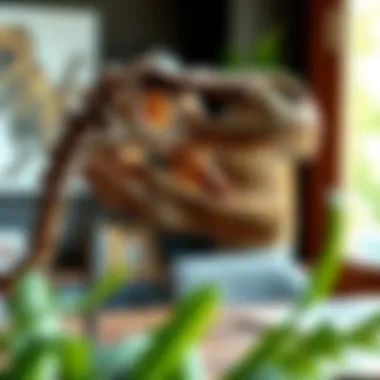

Utilizing natural light effectively
Incorporating strategies for utilizing natural light effectively can elevate fossil decor, enhancing the textures and colors within each piece. Positioning fossils in well-lit areas can bring translucent elements to life, showcasing the intricate details that might otherwise go unnoticed in shadows. Sunlight can cast dramatic and interesting shadows, leading to a dynamic interplay of light and form that alters as the day progresses.
Particularly in rooms that enjoy ample natural light, choosing placements by windows or skylights can enhance the vitality of fossil pieces, but care should be taken to avoid direct sunlight that can cause fading over time. The benefits of capturing the essence of these relics in light can provide a unique allure to the overall space, breathing life into the silent stories held within each fossil.
Care and Maintenance of Fossil Decor
Caring for dinosaur fossil decor is not just a chore; it's an essential aspect of preserving these remarkable pieces of history. Having a fossil in your space is akin to hosting a conversation with eons gone by. However, neglecting them can lead to deterioration, diminishing their aesthetic appeal and even their educational value. Understanding how to care for and maintain these relics is vital for any collector or enthusiast. This section aims to provide practical guidance on cleaning techniques and preservation practices, ensuring that these wonders remain in prime condition for years to come.
Cleaning Techniques
Suitable materials and tools
When it comes to cleaning dinosaur fossil decor, choosing the right materials and tools is critical. You'll want a soft brush, perhaps a paintbrush or a makeup brush, to gently remove dust without scratching the surface. Avoid harsh chemicals that can warp or discolor important details. Instead, opt for mild soap mixed with warm water when deeper cleaning is needed. This simple, yet effective cleaning solution is excellent for removing grime, while keeping the integrity and appearance intact.
- Key characteristics: Gentle yet thorough in cleaning.
- Unique features: Prevents damage during the process.
- Advantages: Preserves details well, maintains aesthetic quality.
- Disadvantages: Requires careful handling for best results.
Avoiding damage during cleaning
Damage can happen in an instant if one is not careful during cleaning. The approach matters just as much as the tools. Always dust fossils in a top-to-bottom technique, allowing any debris to fall downwards. When cleaning near fragile areas, it's crucial to be ever so gentle. This careful attention is particularly beneficial for fossils that might have fragile textures or delicate formations.
- Key characteristic: Focused on preservation.
- Unique features: Emphasizes careful techniques to avoid mishaps.
- Advantages: Minimizes risk while ensuring cleanliness.
- Disadvantages: Requires slow, methodical effort.
Preservation Practices
Environmental controls
The environment where you display your dinosaur fossil decor plays a huge role in preservation. Fossils are sensitive to humidity and temperature fluctuations. Ideally, keep them in a climate-controlled setting, away from direct sunlight, which can lead to fading or cracking over time. These small adjustments to your living space can greatly extend the life of your prized pieces.
- Key characteristics: Stable conditions are pivotal for longevity.
- Unique features: Simple adjustments can have lasting effects.
- Advantages: Protects from environmental damage.
- Disadvantages: May require investment in climate control devices.
Protective display options
Protective display options come in various forms, from locked display cases to glass domes. These solutions not only protect from physical damage but can also mitigate exposure to harmful environmental factors. For example, UV-filtering glass in display cases can significantly reduce the risk of fading. There’s something gratifying about displaying your fossils in a manner that enhances their beauty while also ensuring their longevity.
- Key characteristics: Shields from damage while showcasing beauty.
- Unique features: Allows visibility without compromising safety.
- Advantages: Balances aesthetics and protection.
- Disadvantages: May come at a higher cost.
Cultural Context of Dinosaur Fossil Decor
Understanding the cultural context of dinosaur fossil decor is a key component in grasping its significance and appeal. This context not only reveals how society perceives fossils, but also showcases how these ancient relics have been integrated into modern design and art. Fossil decor transcends mere aesthetics; it is intertwined with cultural narratives and historical interpretations that shape our experience of these items. Today, their presence in homes and public spaces serves as a bridge between natural history and artistic expression.
Globally Influenced Styles
Cultural variations in fossil decor
Cultural variations create a rich tapestry within the realm of fossil decor, reflecting regional histories and artistic traditions. In some cultures, fossils are considered sacred, displaying a strong connection with the earth's ancient past. For instance, in parts of China, fossilized pieces are often used in traditional Feng Shui practices, believed to bring balance and good fortune. The incorporation of these items can serve as unique conversation starters, educating onlookers about different beliefs and practices while showcasing the deep-rooted appreciation of history.
On the other hand, in Western cultures, you might find dinosaur fossils as humorous decor in casual settings, which speaks to a different interpretation. This lighter approach can make the concept of ancient creatures more approachable, particularly for children. However, this casualness can sometimes overshadow the scientific significance, reducing these valuable items to mere novelties. A balanced view respects both the cultural variations and the depth of history behind these fossils.
How heritage shapes design choices
Heritage plays a pivotal role in shaping design choices related to dinosaur fossil decor. Each region’s narrative informs how these objects are displayed and valued. For instance, Native American cultures often view fossils through a lens of spirituality and connection to the environment. Their intricate weaving of stories and art reflects an inherent respect for the past, influencing how fossils are incorporated into their art and decor.
Conversely, in contemporary upscale designs, there’s often a push to create a sophisticated aesthetic that aligns fossil decor with modern minimalist elements. Using high-quality replicas or authentic pieces can reflect both an appreciation for history and a desire for exclusivity. However, this modern interpretation can sometimes lead to the commodification of fossils, where the focus shifts from respect for the history to mere decorative elements. Thus, the challenge lies in balancing heritage with contemporary tastes, ensuring that the stories and meanings behind fossils are respected and shared.
Artistic Interpretations
Art movements inspired by fossils
Art movements like Surrealism and Naturalism have found inspiration in the captivating mysteries of the past, specifically within fossils. Artists have long delved into themes of life, decay, and the passage of time, often using fossils as visual metaphors. This cross-pollination enriches the narrative surrounding dinosaur fossils, as they become symbols of nature's evolution and humanity's curiosity about its past.
In many cases, showcasing fossils within an artistic dialogue can reinforce their aesthetic appeal. Paintings or sculptures that incorporate fossil-like textures or forms can create a visual bridge between natural history and contemporary artistry. However, the challenge for artists often lies in navigating the perilous line between inspiration and exploitation, ensuring that the integrity of the fossils is upheld.
Contemporary artists incorporating fossils
Today, numerous contemporary artists weave fossils into their work, bridging the gap between science and art. For instance, some have used 3D printing technology to replicate fossils for installations that educate the public about paleontological findings. This approach not only makes paleontology accessible but also invites viewers to engage with fossils on a level that extends beyond mere decoration.
Others may take a more abstract route, drawing inspiration from fossil shapes and patterns to create distinct pieces that blur the lines between art and nature. This leads to a fusion of aesthetics that caters to a growing audience that seeks to understand the intersection of science and artistry.
Whether through installation, sculpture, or painting, the manner in which artists utilize fossils often reflects deeper themes of time, existence, and respect for the earth's history. However, it’s equally crucial that these representations do not diminish the scientific essence of fossils; rather, they should celebrate their historical and cultural significance.


Fossil decor, when viewed through this lens of cultural context and artistic interpretation, becomes more than just an ornamental choice. It is a testament to humanity's ongoing fascination with the past and our journey to understand our place within it.
Trends and Future of Dinosaur Fossil Decor
The trends and future of dinosaur fossil decor are more than just passing whims in interior design; they represent a growing appreciation for the ancient world and, more importantly, for sustainable living. As eco-awareness seeps into the very foundations of design choices, incorporating dinosaurs into home decor has gone from a niche interest to a popular trend. Such decor choices not only tell a story but also serve as conversation starters, appealing to both collectors and casual enthusiasts alike. In this section, we will break down the evolving design trends and forecast potential market growth around dinosaur fossil decor.
Emerging Design Trends
Sustainable materials
Sustainable materials have become a major player in the realm of home decor. When it comes to fossil pieces, the use of sustainably sourced resources aligns beautifully with the sentiment modern homeowners carry today—protecting the environment. Many collectors favor items that come from ethical practices, whether that be recycled materials or those sourced from suppliers that pay close attention to their ecological footprint.
The key characteristic here is renewability. Fossil decor made with reconstituted materials or repurposed items reduces waste and minimizes the demand for virgin resources. Why is this a popular choice? Essentially, consumers are becoming savvier, and they’ve made a conscious decision to support brands that show responsibility towards nature. What sets these materials apart is their ability to mesh well with various decor styles, from rustic to ultra-modern.
However, potential downsides do exist. Some might argue that the appeal of fossil decor lies in its originality, and often, sustainable materials lack the unique, one-of-a-kind essence that authentic fossils possess. Nonetheless, the trade-off is worth considering.
Minimalist approaches
Minimalist approaches are gaining traction as well, especially when thinking about how to display dinosaur fossil decor effectively. Emphasizing simplicity, this design philosophy aims to declutter spaces and focus on the statement pieces. Fossils, be they real or replicas, can serve as stunning focal points when displayed thoughtfully.
The hallmark of minimalist decor is functionality married to aesthetics. It strips away excess, allowing the beauty of the organic forms to shine. This approach is particularly beneficial because it creates peace of mind in homes often buzzed with clutter. The unique feature of minimalism lies in its ability to emphasize a single fossil piece, showcasing its intricate details without distraction.
However, the downside can be that a strictly minimalistic display might result in some pieces feeling isolated or overlooked. The challenge is striking the right balance, ensuring the fossil decor doesn’t appear abandoned, but rather celebrated amidst a clean backdrop.
Predictions for Market Growth
Demand among new collectors
New collectors are reshaping the landscape of dinosaur fossil decor. Their enthusiasm for paleontology and fossil collecting is creating ripples in the market. This craving for unique pieces is noticeable; with people increasingly seeking collectibles that tell a story about Earth's history. New collectors tend to prioritize authenticity over mass-produced replicas, believing that owning a piece of the past adds immense value.
This interest signals a shift in the demographic of collectors. Many eager to explore these items for both personal passion and investment potential navigate platforms like Facebook Marketplace and specialized forums on sites like reddit.com. Collectors often share insights about their finds, fostering a community that keeps the enthusiasm alive.
On the flip side, this increased demand might inflate prices, making it challenging for newcomers to break into the market. Moreover, sourcing authentic fossils poses ethical considerations as well, necessitating a sharp awareness around provenance and legality.
Potential for customization
Customization options for dinosaur fossil decor are like icing on the cake. The ability to have pieces tailored to fit individual aesthetics makes it a juicy prospect for many collectors. Whether it’s choosing colors, materials, or sizes, customization allows for a personal touch that speaks volumes in home decor.
This particular trait provides an edge—personalization resonates deeply within the current consumer landscape where uniqueness is prized. Many businesses today are tapping into this trend by offering bespoke fossil decor, tailored specifically to the buyer’s desires.
However, there can sometimes be a precarious balance to strike. Excessive customization could risk walking the line between authentic representation and whimsical design that may not accurately reflect the significance of the original fossils.
In sum, as we delve deeper into the trends and future of dinosaur fossil decor, one thing shines through clearly: This realm intertwines art, science, and sustainability beautifully, capturing the imagination and heart of many.
Educational Value of Dinosaur Fossil Decor
Dinosaur fossil decor represents more than just aesthetic appeal; it serves as a medium for education and inspiration about Earth’s history. Integrating such decor into homes or learning environments not only enhances the visual experience of a space but also ignites curiosity about paleontology. The benefits of using dinosaur fossil decor extend into realms both informational and interactive, making it a compelling choice for collectors and enthusiasts alike.
Inspiring Curiosity about Paleontology
Attracting interest in natural history
Dinosaur fossils are often seen as gateways into the grand narrative of our planet’s past. Just the mention of dinosaurs sends a wave of excitement rippling through both children and adults. This palpable fascination makes fossil decor a strong contender for educational settings and homes alike. The key characteristic of this decor is how it draws attention, acting like a magnet for eager minds. Fossil replicas, like those of the imposing Triceratops or the notorious Tyrannosaurus Rex, can spark discussions and ignite imaginations.
"Fossil decor isn’t just about decoration, it's about discovery."
Utilizing dinosaur fossils as decor connects the past with the present, showcasing the incredible history and diversity of life on Earth. This unique feature plays a significant role in enriching conversations about evolution and the planet’s ecosystems. However, there is a cautious note here; reliance on such decor should not replace thorough educational endeavors but instead complement them.
Encouraging educational discussions
Using dinosaur fossil decor as a conversation starter cultivates a culture of inquiry and exploration. This aspect is instrumental in encouraging dialogues around science and history. Furthermore, it often becomes a central piece in gatherings, spurring curiosity and engagement.
Such decor encourages people, especially young ones, to ask questions: “What did these creatures eat?” or “How did they go extinct?” These discussions are vital for deepening understanding and promoting a love for science. Yet, while engaging, it's essential to guide these discussions with accurate information to ensure misconceptions do not arise. Encouragement in learning can often lead to misunderstandings, so collaborative discussions may be more beneficial than sporadic statements of fact.
Potential in Learning Environments
Using decor as teaching aids
In learning environments, dinosaur fossil decor proves to be an effective teaching aid. Teachers can utilize these interesting artifacts to create an engaging classroom atmosphere. They serve as stimuli that encourage students to dive deeper into subjects such as geology, biology, and environmental science. The visual aspect of having dinosaur fossils or replicas nearby allows for a tactile learning experience where students can relate more directly to the materials they study.
However, sometimes, this method may lead to distractions if not introduced effectively. Instructors must balance between hands-on exploration and maintaining academic focus, ensuring that these beautiful pieces enrich rather than divert from the intended lesson.
Bridging art and science
Dinosaur fossil decor acts as a bridge between art and science, demonstrating how aesthetic sensibilities can enhance educational themes. This interplay is vital for fostering creativity among learners. Displaying fossils in unique forms, such as sculptures or artistic representations, combines scientific inquiry with artistic expression. This multifaceted approach allows for a broader appreciation of both disciplines.
On the downside, it may sometimes dilute the scientific rigor needed in educational contexts. If not carefully orchestrated, art can overshadow the educational core. Educators should strive for a balance where the artistic renditions enhance, but do not replace, factual understanding. This approach emphasizes that both art and science can coexist harmoniously in educational frameworks.



